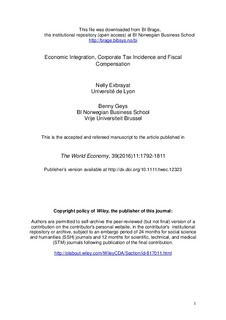| dc.contributor.author | Exbrayat, Nelly | |
| dc.contributor.author | Geys, Benny | |
| dc.date.accessioned | 2015-09-02T22:50:07Z | |
| dc.date.accessioned | 2016-12-07T11:44:05Z | |
| dc.date.available | 2015-09-02T22:50:07Z | |
| dc.date.available | 2016-12-07T11:44:05Z | |
| dc.date.issued | 2016 | |
| dc.identifier.citation | The World Economy, 39(2016)11:1792-1811 | nb_NO |
| dc.identifier.issn | 1467-9701 | |
| dc.identifier.issn | 0378-5920 | |
| dc.identifier.uri | http://hdl.handle.net/11250/2424506 | |
| dc.description.abstract | Higher corporate taxes are often argued to depress wages (a tax incidence effect), while higher wages may require compensation via lower corporate tax rates (a fiscal compensation effect). Yet, existing empirical evidence ignores that i) both effects are likely to occur simultaneously (necessitating a joint estimation approach), and ii) capital mobility might play a critical moderating role for the strength of both effects. Using a panel dataset comprising 24 OECD countries over the period 1982-2007, we address both these deficiencies. This clearly illustrates the simultaneous existence of tax incidence and fiscal compensation effects. Moreover, capital mobility (and the ensuing relative bargaining power of economic agents) has a significant influence on both the prevalence and strength of these effects. | |
| dc.language.iso | eng | nb_NO |
| dc.publisher | Wiley | nb_NO |
| dc.title | Economic Integration, Corporate Tax Incidence and Fiscal Compensation | nb_NO |
| dc.type | Journal article | nb_NO |
| dc.type | Peer reviewed | nb_NO |
| dc.date.updated | 2015-09-02T22:50:06Z | |
| dc.source.journal | The World Economy | nb_NO |
| dc.identifier.doi | http://dx.doi.org/10.1111/twec.12323 | |
| dc.identifier.cristin | 1261643 | |
| dc.description.localcode | 1, Forfatterversjon | nb_NO |
